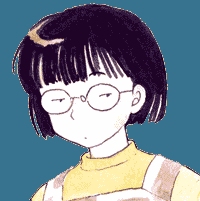Interview With Rumiko Takahashi

Interview by: Urian Brown
Inuyasha has numerous demons that stem from classic Japanese folklore. How much of what you know about folklore came from research as an adult, and how much of what you know came from your childhood memories of these stories?
Takahashi: Since I was a child I've drawn inspiration from magazine photos and whatnot, but when
Inuyasha began I tried actively searching more and more for demon and goblin illustrations. But while working on the series I would just create original characters.
Much of the mythology in Inuyasha is Japanese, but there are occaisonal references to other mythology, like for instance when Inuyasha tries to pull the Tessaiga out of his father's body, which is similar to the Arthurian legend of The Sword and the Stone. What other types of mythology have influenced you?
Takahashi: I don't really think there are any myths out there like
Inuyasha.
The character Nobunaga (Amari) in Inuyasha wishes to protect real life no matter how grotesque or deformed, yet the similarly named Nobunaga Oda of Japanese history had no problem taking human lives. Is this character an intentional jest at the famous historical figure?
Takahashi: I did not intend any satire so really there's no connection. I thought that Nobunaga Amari would be an ideal shonen manga character.
What was the inspiration for Sango's Hiraikotsu boomerang?
Takahashi: Just a normal boomerang, really.
Your series are known for both the funny and the dramatic conflicts between siblings. Do you draw much inspiration from real life?
Takahashi: There's no connection to my real life.

The Inuyasha anime comes straight from the manga, yet the movies do not. How much of the story for the movies did you work on, and how much creative control did you have?
Takahashi: I did participate in the script writing meetings, but the scriptwriters were so amazing that I pretty much left it up to them.
[1]
For many years, you have enjoyed success in America and are considered being one of the first manga artists to achieve fame in the States. Now your creation Inuyasha is shown on the Cartoon Network (a large cable station in the U.S.) and it is one of the highest rated shows. Did you ever think you would achieve success in the U.S. of this caliber, and what are your feelings about having done so?
Takahashi: I am happy that many people in the U.S. are reading my work and watching the adapted anime, I'm very happy.
Your artwork has a real shonen style to it. When you first became a manga artist did you consciously choose not to draw in a shojo style like other female manga artists?
Takahashi: Because I loved shonen manga since I was a child I've only ever wanted to draw in that style.
[2]
Even though the Inuyasha anime has ended in Japan, the manga still continues. What are your feelings on the Inuyasha anime? Do you feel it did your manga justice?
Takahashi: With Sunrise producing the anime and their high production quality, I think I've been very fortunate.
You have been drawing high-quality manga for a number of years now. Looking back at your life how do you feel about the profession you have chosen? If you could live your life again would you be a manga artist?
Takahashi: Because I do feel this is really my true calling, if I were reborn I'd have to say I'd definitely be drawing again.
Is there any chance you will finish one of your earlier manga series, One Pound Gospel?
Takahashi: I think I'd welcome an end to it sometime in the future.
[3]
Your North American fans still fondly remember your convention visit in 2000. Are you interested in visiting America again?
Takahashi: It was very pleasant to go so if I have the chance I would absolutely like to do it again.
Do you have a message for your worldwide fans?
Takahashi: To my fans around the world that I've made happy, I'm truly glad to be doing this work. I'll be drawing some new works soon, so please read them.
[4]
Footnotes
- [1] Takahashi's involvement in any of the anime (not just Inuyasha) based on her work is typically fairly limited. On the television shows she sometimes makes suggestions (she requested Kappei Yamaguchi play Inuyasha for instance) early in the production but typically not much in the day to day running of the show. When it comes to theatrical adaptations if there is a guest character appearing in a film then Takahashi will provided the design for them. She had designed all of the "movie-only" characters from the Urusei Yatsura, Ranma 1/2 and Inuyasha films. You can read about one of the productions meetings for Urusei Yatsura Movie 5 that Takahashi was involved in here.
- [2] Takahashi grew up reading the manga her brother purchased which was mostly shonen manga. Takahashi discusses many of the manga she read as a child in this interview.
- [3] Ultimately, One Pound Gospel concluded in 2007, two years after this interview took place. The interviewer likely asked about it because some chapters of One Pound Gospel were published in Animerica magazine, which was where this interview originally appeared.
- [4] This interview was not only to promote the third Inuyasha film but also to conclude Animerica. This interview ran in the final issue, and Viz devoted many pages of the magazine to coverage of Rumiko Takahashi over the years as she was such a key figure in their history as a publisher. Animerica was seeing more competition from the American edition of Newtype as well as Otaku USA. Similarly timely coverage in the magazine age was beginning to struggle when the internet was becoming increasingly ubiquitous.




